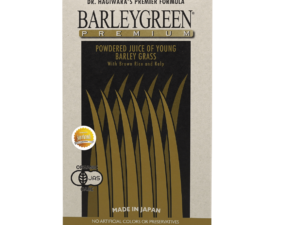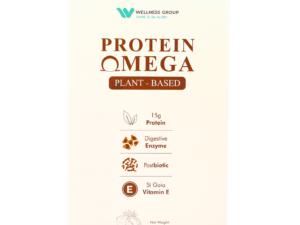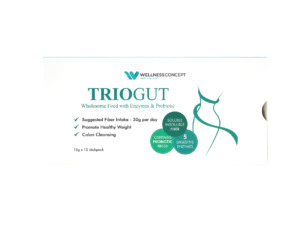Did you know 95% of Malaysian adults fail to meet daily fiber recommendations? This gap in nutrition silently impacts a vital internal system more than most realize. While many associate dietary fiber with general wellness, emerging research reveals its most profound effects center on one specific area: the gut.
Scientific studies show that consuming adequate fiber strengthens intestinal walls, feeds beneficial bacteria, and helps regulate blood sugar. These processes directly support long-term health by reducing risks for chronic conditions like diabetes and colon-related diseases. For Malaysians navigating busy lifestyles, understanding this connection could transform daily food choices.
Wellness Group’s nutrition experts simplify this science into practical strategies. Through personalized guidance on digestive enzyme production and meal planning, they help clients optimize their intake of soluble and insoluble fibers. Available via WhatsApp at +60123822655, their team provides tailored advice during extended business hours.
Key Takeaways
- Fiber’s greatest impact centers on gut health and colon function
- Proper intake reduces chronic disease risks by up to 30%
- Most Malaysians consume less than half the recommended daily fiber
- Soluble and insoluble fibers serve distinct roles in digestion
- Strategic dietary changes can significantly improve microbiome balance
- Professional guidance ensures optimal fiber consumption for individual needs
Understanding Fiber and Its Role in Health
Think of fiber as your body’s natural maintenance crew. Unlike other carbohydrates, it doesn’t break down during digestion. Instead, it travels through your digestive system like a sponge, absorbing waste and keeping things moving smoothly.
Defining Dietary Fiber

Click to 了解更多
The Institute of Medicine describes dietary fiber as plant-based materials our bodies can’t fully process. Found in fruits, vegetables, and whole grains, these non-digestible carbohydrates act like nature’s broom. They sweep through intestines while providing structure to plants.
Why Fiber Matters for the Body
Regular fiber intake does more than prevent constipation. It feeds trillions of gut bacteria that influence everything from immunity to mood. Studies show people who meet the 25 to 30 grams daily target have better blood sugar control and lower inflammation.
Yet most Malaysians eat less than half this amount. Simple swaps like choosing brown rice over white or snacking on guava instead of chips can bridge this gap. When beneficial bacteria thrive, they produce compounds that strengthen intestinal walls and protect overall health.
Exploring the Different Types of Fiber
Have you ever wondered why some fibers act like sponges while others work like scrub brushes? The answer lies in their unique structures and functions. Fiber isn’t a single substance—it’s a diverse group with distinct roles that impact digestion differently.
Soluble vs. Insoluble Fiber Explained
Soluble fiber dissolves in water, forming a gel that slows digestion. This helps regulate blood sugar by delaying nutrient absorption. Oats and chia seeds are classic examples—they expand in liquid, creating a satisfying thickness.
Insoluble fiber stays intact through digestion. It adds bulk to stool, acting like nature’s broom to keep things moving. Whole grains and vegetable skins provide this roughage, making them essential for regularity.
Fermentable and Non-Fermentable Fibers
Scientists now categorize fiber by how gut bacteria interact with it. Fermentable types like pectin become food for beneficial microbes. As these fibers break down, they produce short-chain fatty acids that strengthen intestinal walls.
Non-fermentable fibers pass through unchanged, providing mechanical cleansing. Most plants contain both types, which is why varied fiber sources matter more than focusing on one category.
“Choosing diverse plant foods ensures you get all fiber types working together—like a wellness team for your gut.”
For Malaysians, this means mixing lentils, barley, and local favorites like ciku fruit. Understanding these differences helps tailor diets for specific needs, whether managing blood sugar or improving digestion.
What Organ Benefits from Fiber?
Deep within the digestive tract lies a powerhouse that thrives on plant-based nutrition. This unsung hero transforms dietary roughage into vital compounds that shield the entire body.
Fiber's Impact on the Colon
The large intestine houses over 10 trillion microbes that feast on undigested fiber. Through bacterial fermentation, these friendly organisms produce short-chain fatty acids like butyrate. Studies show butyrate fuels colon cells, strengthening the gut lining and reducing inflammation.
This process maintains the mucus layer protecting intestinal walls. A robust barrier prevents harmful substances from entering the bloodstream, lowering risks for digestive disorders. Research links adequate fiber intake to 30% lower chances of colorectal issues.
| Fiber Type | Role in Colon Health | Common Sources |
|---|---|---|
| Soluble | Feeds beneficial bacteria | Oats, legumes |
| Insoluble | Promotes bowel movements | Whole grains, veggies |
Beyond physical effects, colon health influences mental wellness through nerve connections to the brain. Balanced gut flora supports immune responses and mood regulation. While multiple systems gain advantages, the colon experiences the most direct transformations from consistent fiber consumption.
Malaysians can enhance their digestive system by incorporating local superfoods like ulam herbs and jackfruit. Simple changes create lasting improvements in gut health and overall vitality.
The Vital Connection Between Fiber and Gut Health

Click to 了解更多
Imagine your gut as a bustling metropolis where trillions of microscopic residents work around the clock. These 38 trillion bacterial cells—representing 500-1,000 species—form a living ecosystem that thrives on plant-based fuel. Their survival depends entirely on the fiber we consume, creating a partnership older than agriculture itself.
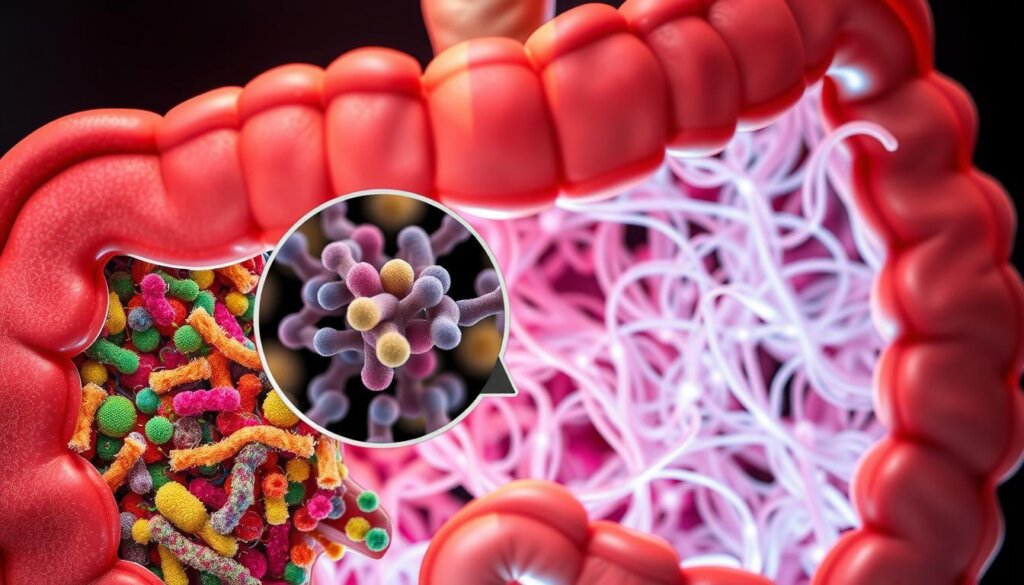
Feeding the Good Bacteria
This microbial community repays its dietary debt in remarkable ways. When fed properly, gut bacteria produce three key fatty acids: acetate, propionate, and butyrate. Of these, butyrate acts as the colon’s primary energy source, powering 70% of its cellular functions.
Local favorites like ulam leaves and ciku fruit provide ideal bacterial nourishment. A balanced microbiome strengthens intestinal walls, preventing harmful substances from leaking into the bloodstream. This barrier function reduces systemic inflammation linked to chronic conditions.
Short-Chain Fatty Acids and Colon Health
Butyrate’s benefits extend beyond basic cell maintenance. Studies show it:
- Activates genes that suppress tumor growth
- Regulates immune responses in the gut lining
- Enhances nutrient absorption efficiency
These processes create a ripple effect throughout the body. Improved gut health correlates with better mood regulation and stronger defenses against pathogens. For Malaysians juggling busy schedules, prioritizing fiber-rich meals ensures their microbial allies stay productive.
Regular consumption of oats, legumes, and whole grains maintains this symbiotic relationship. As research reveals deeper connections between digestion and overall health, one truth remains clear: a thriving gut ecosystem starts at the dinner plate.
Additional Health Benefits of Fiber
Fiber acts like a Swiss Army knife for your body—versatile tools packed into one simple nutrient. Beyond supporting digestion, it plays surprising roles in managing vital health markers. These hidden advantages make fiber a cornerstone of preventive care.
Managing Blood Sugar and Cholesterol
Soluble fiber forms a gel-like barrier in the intestines. This slows carbohydrate breakdown, preventing sudden blood sugar spikes. Studies show this effect helps maintain stable glucose levels—especially valuable for those managing diabetes.
This sticky substance also traps bile acids containing cholesterol. To replace lost bile, the liver pulls cholesterol from the bloodstream. Regular oat consumption can lower LDL (“bad”) cholesterol by 5-10% within weeks.
Weight Management and Digestive Regularity
High-fiber foods expand in the stomach, triggering fullness signals. People who start meals with vegetable soups often eat 20% fewer calories. Gut bacteria convert certain fibers into compounds that boost metabolism.
For those battling constipation, insoluble fiber adds bulk to stool. It acts like a natural lubricant, easing bowel movements without harsh laxatives. Pairing fiber with water maximizes this effect.
| Benefit | Mechanism | Top Sources |
|---|---|---|
| Blood sugar control | Slows glucose absorption | Barley, legumes |
| Cholesterol reduction | Binds bile acids | Oats, psyllium |
| Weight management | Enhances satiety | Apples, chia seeds |
These effects create a protective web against chronic disease. Research links adequate fiber intake to 15-30% lower risks of heart conditions and type 2 diabetes. For Malaysians, embracing local favorites like kacang botol (winged beans) makes these advantages deliciously achievable.
Practical Tips to Increase Your Fiber Intake
Boosting your fiber doesn’t require drastic changes—just smarter swaps. Adults should aim for 22-34 grams daily, but sudden increases can cause bloating. Start by adding 5 grams weekly—try mixing brown rice with white during the first month.
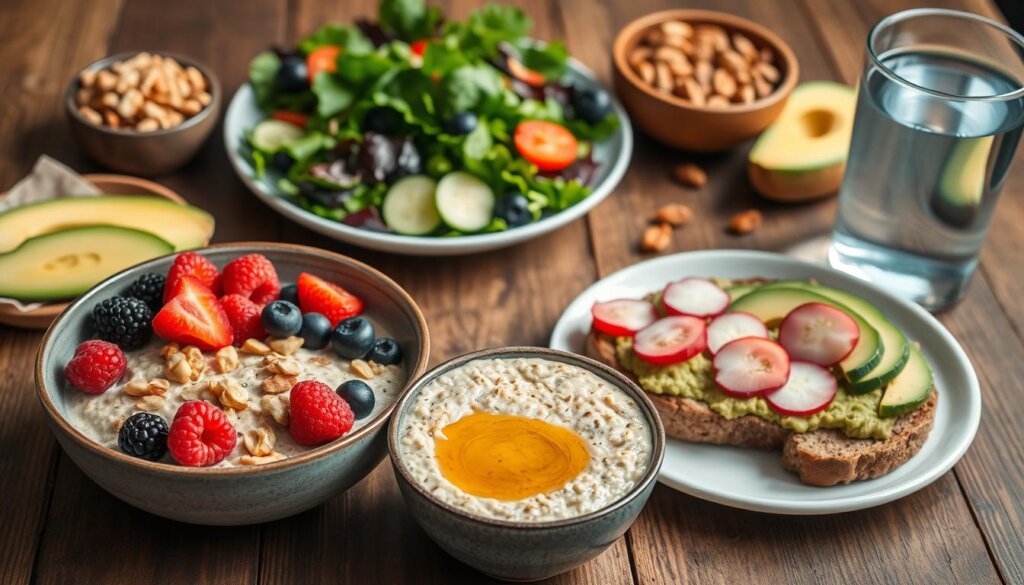
Fiber-Rich Foods for Every Meal
Breakfast sets the tone. Oatmeal with sliced mango provides 4 grams, while whole-grain roti canai offers 3 grams. Lunch salads gain power with winged beans (kacang botol) or chickpeas—both deliver 5-7 grams per serving.
Dinner becomes a fiber feast with stir-fried vegetables and barley rice. Snack smart: guava with skin (3 grams) or pumpkin seeds (5 grams per ounce). Local markets stock perfect options like jackfruit and ulam herbs.
Simple Meal Ideas and Recipes
Try these effortless upgrades:
- Blend chia seeds into teh tarik for morning drinks
- Top avocado toast with roasted chickpeas
- Swap noodles for spiralized cucumber in laksa
| Meal Time | Fiber Boosters | Malaysian Swaps |
|---|---|---|
| Breakfast | Oats, berries, flaxseeds | Brown rice porridge |
| Lunch | Bean salads, whole grains | Quinoa nasi kerabu |
| Dinner | Roasted veggies, lentils | Stir-fried kailan |
Always pair fiber with water—aim for 8 glasses daily. This prevents constipation and helps soluble fibers form their beneficial gel. For specialized guidance on best fiber sources for cholesterol management, consult nutrition experts.
Remember: gradual changes create lasting habits. Start with one fiber-packed meal daily, then build from there. Your gut—and overall health—will thank you.
Wellness Group: Expert Advice and Contact Information
Nutritional guidance becomes personal when experts tailor it to your plate. Wellness Group leads Malaysia’s health consultation scene with science-backed strategies that transform dietary guidelines into actionable steps. Their team simplifies complex nutrition science for busy adults seeking lasting wellness changes.
Your Nutrition Partner on WhatsApp
Access personalized dietary plans through a simple message at +60123822655. Wellness Group’s nutritionists craft fiber-rich meal strategies using local ingredients like whole grains and tropical fruits. They address specific needs—whether managing cholesterol or boosting gut health—through convenient digital consultations.
Flexible Support for Modern Lifestyles
Services operate Monday-Friday (9:30 am-6:30 pm) and weekends (10 am-5 pm), accommodating Malaysia’s diverse schedules. Clients receive:
- Customized fiber diet plans matching cultural preferences
- Science-based advice aligned with Dietary Guidelines for Americans
- Ongoing support for adopting sustainable eating habits
One client shared: “They helped me replace white rice with barley—my energy levels doubled!” This approach helps people navigate modern dietary challenges while honoring traditional flavors.
| Service Feature | Health Benefit | Implementation |
|---|---|---|
| Personalized Plans | Targeted nutrient intake | WhatsApp-based assessments |
| Localized Recipes | Improved diet adherence | Malaysian ingredient focus |
| Progress Tracking | Long-term habit formation | Weekly check-ins |
By combining global nutrition standards with local culinary wisdom, Wellness Group makes optimal health achievable for every Malaysian household.
Conclusion
Modern science confirms that the colon thrives when fueled by dietary fiber. This vital structure relies on nutrients produced by gut bacteria during fermentation—especially butyrate, which strengthens intestinal walls and reduces disease risk.
Consuming 22-34 grams daily unlocks multiple advantages. Stable blood sugar, balanced cholesterol, and healthy body weight all trace back to fiber’s dual role in digestion and microbiome support. Yet most adults consume barely half this amount, missing critical health protections.
Simple swaps make progress achievable. Adding oats to breakfast or choosing whole-grain options helps bridge the gap. Local superfoods like ulam herbs and ciku fruit offer tasty ways to boost intake while honoring Malaysian culinary traditions.
Prioritizing fiber-rich meals creates a ripple effect across the body’s systems. From smoother digestion to stronger defenses against chronic conditions, the benefits extend far beyond gut health. For personalized strategies, Wellness Group’s nutritionists provide actionable guidance via WhatsApp at +60123822655.
FAQ
Which organ benefits most from fiber intake?
The colon, part of the digestive system, gains significant advantages. Soluble and insoluble fibers work together to support bowel regularity, reduce constipation, and lower the risk of colorectal disease by promoting a healthy gut environment.
How does soluble fiber differ from insoluble fiber?
Soluble fiber dissolves in water, forming a gel-like substance that slows sugar absorption and helps manage cholesterol. Insoluble fiber adds bulk to stool, aiding digestion. Both types, found in oats, beans, and vegetables, play unique roles in overall health.
Can fiber improve gut bacteria balance?
Yes! Fermentable fibers act as prebiotics, feeding beneficial gut bacteria like Bifidobacteria. This process produces short-chain fatty acids, which strengthen colon cells and may reduce inflammation linked to chronic diseases.
How does fiber help manage blood sugar levels?
Soluble fiber slows carbohydrate breakdown, preventing rapid blood sugar spikes. Foods like apples, chia seeds, and lentils are excellent choices for maintaining steady glucose levels, especially for those with diabetes or insulin resistance.
What are easy ways to add more fiber to meals?
Start with whole grains like quinoa or brown rice, snack on almonds or berries, and incorporate legumes into soups. Adding flaxseeds to smoothies or avocado to salads also boosts daily intake without drastic diet changes.
Does fiber support weight management efforts?
High-fiber foods increase satiety, helping people feel full longer. This reduces overeating and supports gradual weight loss. For example, a breakfast with oatmeal and raspberries provides lasting energy and curbs mid-morning cravings.
Should someone consult a nutritionist about fiber needs?
Absolutely. Wellness Group experts tailor recommendations based on individual health goals. They can advise on balancing soluble and insoluble fibers, adjusting intake for conditions like IBS, or creating meal plans rich in whole grains and vegetables.
How can someone contact Wellness Group for personalized advice?
Reach out via WhatsApp at +60123822655 during business hours (Mon-Fri, 9 AM–6 PM MYT). Their team provides guidance on fiber-rich diets, digestive health strategies, and sustainable lifestyle changes for long-term wellness.


